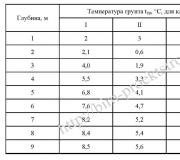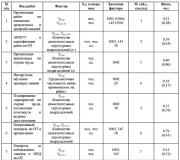How to reduce large numbers to a common denominator. Reducing fractions to a new denominator - rules and examples
In this lesson we will look at reducing fractions to a common denominator and solve problems on this topic. Let's define the concept of a common denominator and an additional factor, and remember about relatively prime numbers. Let's define the concept of the lowest common denominator (LCD) and solve a number of problems to find it.
Topic: Adding and subtracting fractions with different denominators
Lesson: Reducing fractions to a common denominator
Repetition. The main property of a fraction.
If the numerator and denominator of a fraction are multiplied or divided by the same natural number, you get an equal fraction.
For example, the numerator and denominator of a fraction can be divided by 2. We get the fraction. This operation is called fraction reduction. You can also perform the inverse transformation by multiplying the numerator and denominator of the fraction by 2. In this case, we say that we have reduced the fraction to a new denominator. The number 2 is called an additional factor.
Conclusion. A fraction can be reduced to any denominator that is a multiple of the denominator of the given fraction. To bring a fraction to a new denominator, its numerator and denominator are multiplied by an additional factor.
1. Reduce the fraction to the denominator 35.

The number 35 is a multiple of 7, that is, 35 is divisible by 7 without a remainder. This means that this transformation is possible. Let's find an additional factor. To do this, divide 35 by 7. We get 5. Multiply the numerator and denominator of the original fraction by 5.
2. Reduce the fraction to denominator 18.

Let's find an additional factor. To do this, divide the new denominator by the original one. We get 3. Multiply the numerator and denominator of this fraction by 3.
3. Reduce the fraction to a denominator of 60.

Dividing 60 by 15 gives an additional factor. It is equal to 4. Multiply the numerator and denominator by 4.
4. Reduce the fraction to the denominator 24

In simple cases, reduction to a new denominator is performed mentally. It is only customary to indicate the additional factor behind a bracket slightly to the right and above the original fraction.

A fraction can be reduced to a denominator of 15 and a fraction can be reduced to a denominator of 15. Fractions also have a common denominator of 15.
The common denominator of fractions can be any common multiple of their denominators. For simplicity, fractions are reduced to their lowest common denominator. It is equal to the least common multiple of the denominators of the given fractions.
Example. Reduce to the lowest common denominator of the fraction and .

First, let's find the least common multiple of the denominators of these fractions. This number is 12. Let's find an additional factor for the first and second fractions. To do this, divide 12 by 4 and 6. Three is an additional factor for the first fraction, and two is for the second. Let's bring the fractions to the denominator 12.
We brought the fractions to a common denominator, that is, we found equal fractions that have the same denominator.
Rule. To reduce fractions to their lowest common denominator, you must
First, find the least common multiple of the denominators of these fractions, it will be their least common denominator;
Secondly, divide the lowest common denominator by the denominators of these fractions, i.e. find an additional factor for each fraction.
Third, multiply the numerator and denominator of each fraction by its additional factor.
a) Reduce the fractions and to a common denominator.

The lowest common denominator is 12. The additional factor for the first fraction is 4, for the second - 3. We reduce the fractions to the denominator 24.
b) Reduce the fractions and to a common denominator.

The lowest common denominator is 45. Dividing 45 by 9 by 15 gives 5 and 3, respectively. We reduce the fractions to the denominator 45.
c) Reduce the fractions and to a common denominator.

The common denominator is 24. Additional factors are 2 and 3, respectively.
Sometimes it can be difficult to verbally find the least common multiple of the denominators of given fractions. Then the common denominator and additional factors are found using prime factorization.
Reduce the fractions and to a common denominator.

Let's factor the numbers 60 and 168 into prime factors. Let's write out the expansion of the number 60 and add the missing factors 2 and 7 from the second expansion. Let's multiply 60 by 14 and get a common denominator of 840. The additional factor for the first fraction is 14. The additional factor for the second fraction is 5. Let's bring the fractions to a common denominator of 840.
Bibliography
1. Vilenkin N.Ya., Zhokhov V.I., Chesnokov A.S. and others. Mathematics 6. - M.: Mnemosyne, 2012.
2. Merzlyak A.G., Polonsky V.V., Yakir M.S. Mathematics 6th grade. - Gymnasium, 2006.
3. Depman I.Ya., Vilenkin N.Ya. Behind the pages of a mathematics textbook. - Enlightenment, 1989.
4. Rurukin A.N., Tchaikovsky I.V. Assignments for the mathematics course for grades 5-6. - ZSh MEPhI, 2011.
5. Rurukin A.N., Sochilov S.V., Tchaikovsky K.G. Mathematics 5-6. A manual for 6th grade students at the MEPhI correspondence school. - ZSh MEPhI, 2011.
6. Shevrin L.N., Gein A.G., Koryakov I.O. and others. Mathematics: Textbook-interlocutor for 5-6 grades of secondary school. Math teacher's library. - Enlightenment, 1989.
You can download the books specified in clause 1.2. of this lesson.
Homework
Vilenkin N.Ya., Zhokhov V.I., Chesnokov A.S. and others. Mathematics 6. - M.: Mnemosyne, 2012. (link see 1.2)
Homework: No. 297, No. 298, No. 300.
Other tasks: No. 270, No. 290
I originally wanted to include common denominator techniques in the Adding and Subtracting Fractions section. But there turned out to be so much information, and its importance is so great (after all, not only numerical fractions have common denominators), that it is better to study this issue separately.
So, let's say we have two fractions with different denominators. And we want to make sure that the denominators become the same. The basic property of a fraction comes to the rescue, which, let me remind you, sounds like this:
A fraction will not change if its numerator and denominator are multiplied by the same number other than zero.
Thus, if you choose the factors correctly, the denominators of the fractions will become equal - this process is called reduction to a common denominator. And the required numbers, “evening out” the denominators, are called additional factors.
Why do we need to reduce fractions to a common denominator? Here are just a few reasons:
- Adding and subtracting fractions with different denominators. There is no other way to perform this operation;
- Comparing fractions. Sometimes reduction to a common denominator greatly simplifies this task;
- Solving problems involving fractions and percentages. Percentages are essentially ordinary expressions that contain fractions.
There are many ways to find numbers that, when multiplied by them, will make the denominators of fractions equal. We will consider only three of them - in order of increasing complexity and, in a sense, effectiveness.
Criss-cross multiplication
The simplest and most reliable method, which is guaranteed to equalize the denominators. We will act “in a headlong manner”: we multiply the first fraction by the denominator of the second fraction, and the second by the denominator of the first. As a result, the denominators of both fractions will become equal to the product of the original denominators. Take a look:
As additional factors, consider the denominators of neighboring fractions. We get:

Yes, it's that simple. If you are just starting to study fractions, it is better to work using this method - this way you will insure yourself against many mistakes and are guaranteed to get the result.
The only drawback of this method is that you have to count a lot, because the denominators are multiplied “all the way”, and the result can be very large numbers. This is the price to pay for reliability.
Common Divisor Method
This technique helps to significantly reduce calculations, but, unfortunately, it is used quite rarely. The method is as follows:
- Before you go straight ahead (i.e., using the criss-cross method), take a look at the denominators. Perhaps one of them (the one that is larger) is divided into the other.
- The number resulting from this division will be an additional factor for the fraction with a smaller denominator.
- In this case, a fraction with a large denominator does not need to be multiplied by anything at all - this is where the savings lie. At the same time, the probability of error is sharply reduced.
Task. Find the meanings of the expressions:
Note that 84: 21 = 4; 72: 12 = 6. Since in both cases one denominator is divided without a remainder by the other, we use the method of common factors. We have:

Note that the second fraction was not multiplied by anything at all. In fact, we cut the amount of computation in half!
By the way, I didn’t take the fractions in this example by chance. If you're interested, try counting them using the criss-cross method. After reduction, the answers will be the same, but there will be much more work.
This is the power of the common divisors method, but, again, it can only be used when one of the denominators is divisible by the other without a remainder. Which happens quite rarely.
Least common multiple method
When we reduce fractions to a common denominator, we are essentially trying to find a number that is divisible by each denominator. Then we bring the denominators of both fractions to this number.
There are a lot of such numbers, and the smallest of them will not necessarily be equal to the direct product of the denominators of the original fractions, as is assumed in the “criss-cross” method.
For example, for denominators 8 and 12, the number 24 is quite suitable, since 24: 8 = 3; 24: 12 = 2. This number is much less than the product 8 · 12 = 96.
The smallest number that is divisible by each of the denominators is called their least common multiple (LCM).
Notation: The least common multiple of a and b is denoted by LCM(a ; b) . For example, LCM(16, 24) = 48 ; LCM(8; 12) = 24 .
If you manage to find such a number, the total amount of calculations will be minimal. Look at the examples:
Task. Find the meanings of the expressions:
Note that 234 = 117 2; 351 = 117 3. Factors 2 and 3 are coprime (have no common factors other than 1), and factor 117 is common. Therefore LCM(234, 351) = 117 2 3 = 702.
Likewise, 15 = 5 3; 20 = 5 · 4. Factors 3 and 4 are coprime, and factor 5 is common. Therefore LCM(15, 20) = 5 3 4 = 60.
Now let's bring the fractions to common denominators:

Notice how useful it was to factorize the original denominators:
- Having discovered identical factors, we immediately arrived at the least common multiple, which, generally speaking, is a non-trivial problem;
- From the resulting expansion you can find out which factors are “missing” in each fraction. For example, 234 · 3 = 702, therefore, for the first fraction the additional factor is 3.
To appreciate how much of a difference the least common multiple method makes, try calculating these same examples using the criss-cross method. Of course, without a calculator. I think after this comments will be unnecessary.
Don't think that there won't be such complex fractions in the real examples. They meet all the time, and the above tasks are not the limit!
The only problem is how to find this very NOC. Sometimes everything can be found in a few seconds, literally “by eye,” but in general this is a complex computational task that requires separate consideration. We won't touch on that here.
When adding and subtracting algebraic fractions with different denominators, the fractions first lead to common denominator. This means that they find one denominator that is divided by the original denominator of each algebraic fraction included in the given expression.
As you know, if the numerator and denominator of a fraction are multiplied (or divided) by the same number other than zero, the value of the fraction will not change. This is the main property of a fraction. Therefore, when fractions are reduced to a common denominator, they essentially multiply the original denominator of each fraction by the missing factor to obtain a common denominator. In this case, you need to multiply the numerator of the fraction by this factor (it is different for each fraction).
For example, given the following sum of algebraic fractions:
It is required to simplify the expression, that is, add two algebraic fractions. To do this, first of all, you need to bring the fraction terms to a common denominator. The first step is to find a monomial that is divisible by both 3x and 2y. In this case, it is desirable that it be the smallest, that is, find the least common multiple (LCM) for 3x and 2y.
For numerical coefficients and variables, the LCM is searched separately. LCM(3, 2) = 6, and LCM(x, y) = xy. Next, the found values are multiplied: 6xy.
Now we need to determine by what factor we need to multiply 3x to get 6xy:
6xy ÷ 3x = 2y
This means that when reducing the first algebraic fraction to a common denominator, its numerator must be multiplied by 2y (the denominator has already been multiplied when reducing to a common denominator). The multiplier for the numerator of the second fraction is looked for in the same way. It will be equal to 3x.
Thus we get: 
Then you can act as with fractions with identical denominators: add up the numerators, and write one common denominator: 
After the transformations, a simplified expression is obtained, which is one algebraic fraction, which is the sum of the two original ones: 
Algebraic fractions in the original expression may contain denominators that are polynomials rather than monomials (as in the example above). In this case, before searching for a common denominator, you should factor the denominators (if possible). Next, the common denominator is collected from different factors. If the multiplier is in several original denominators, then it is taken once. If the multiplier has different powers in the original denominators, then it is taken with the larger one. For example: 
Here the polynomial a 2 – b 2 can be represented as the product (a – b)(a + b). The factor 2a – 2b is expanded as 2(a – b). Thus, the common denominator will be 2(a – b)(a + b).
The denominator of the arithmetic fraction a / b is the number b, which shows the size of the fractions of a unit from which the fraction is composed. The denominator of an algebraic fraction A / B is the algebraic expression B. To perform arithmetic operations with fractions, they must be reduced to the lowest common denominator.
You will need
- To work with algebraic fractions and find the lowest common denominator, you need to know how to factor polynomials.
Instructions
Let's consider reducing two arithmetic fractions n/m and s/t to the least common denominator, where n, m, s, t are integers. It is clear that these two fractions can be reduced to any denominator divisible by m and t. But they try to lead to the lowest common denominator. It is equal to the least common multiple of the denominators m and t of the given fractions. The least multiple (LMK) of a number is the smallest divisible by all given numbers at the same time. Those. in our case, we need to find the least common multiple of the numbers m and t. Denoted as LCM (m, t). Next, the fractions are multiplied by the corresponding ones: (n/m) * (LCM (m, t) / m), (s/t) * (LCM (m, t) / t).
Let's find the lowest common denominator of three fractions: 4/5, 7/8, 11/14. First, let's expand the denominators 5, 8, 14: 5 = 1 * 5, 8 = 2 * 2 * 2 = 2^3, 14 = 2 * 7. Next, calculate the LCM (5, 8, 14) by multiplying all the numbers included into at least one of the expansions. LCM (5, 8, 14) = 5 * 2^3 * 7 = 280. Note that if a factor occurs in the expansion of several numbers (factor 2 in the expansion of denominators 8 and 14), then we take the factor to a greater degree (2^3 in our case).
So, the general one is obtained. It is equal to 280 = 5 * 56 = 8 * 35 = 14 * 20. Here we get the numbers by which we need to multiply the fractions with the corresponding denominators in order to bring them to the lowest common denominator. We get 4/5 = 56 * (4/5) = 224/280, 7/8 = 35 * (7/8) = 245/280, 11/14 = 20 * (11/14) = 220/280.
Reduction of algebraic fractions to the lowest common denominator is carried out by analogy with arithmetic ones. For clarity, let's look at the problem using an example. Let two fractions (2 * x) / (9 * y^2 + 6 * y + 1) and (x^2 + 1) / (3 * y^2 + 4 * y + 1) be given. Let's factorize both denominators. Note that the denominator of the first fraction is a perfect square: 9 * y^2 + 6 * y + 1 = (3 * y + 1)^2. For




